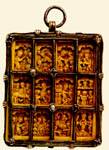|
|
| Byzantine Minor Arts |
early 16th c. Dionysiou Monastery Ivory, silver mount Height 7.5 cm, width 6 cm, thickness 1.5 cm |
|

|
Carved on the ivory tablet of this enkolpion are the scenes of the Dodekaorton, occupying individual rectangular panels arranged in three rows of four. The exceptionally high relief is the result of deep undercutting, and the scenes are actually sunk into the thickness of the ivory. The tiny area of each individual panel means that the scenes are rendered somewhat summarily, especially those with many figures. Characteristic features are the short bodies and large heads, while the figures of Jesus and the Virgin are highlighted by their relatively even larger heads. The scenes unfold under pointed arches, with the identifying inscriptions (in Slavonic) carved in relief above them. With the exception of the pointed arches, all the other technical and stylistic features of this enkolpion were already in evidence in the Late Palaeologan period, in ivories, objects made of steatite and wood-carvings (Weitzmann 1972, no. 31. Kalavrezou-Maxeiner 1985, I, pp. 48-9. Thesauroi p. 44). The continuity of this tradition may be seen in later Russian and post-Byzantine wood-carving, so much of which is decorated with miniature scenes of the Dodekaorton, with their characteristic relief inscriptions (Pyles Mysteriou no. 84). The pointed arch, however, is a Gothic feature, reminiscent of the little Gothic arch motifs so characteristic of post-Byzantine crosses from the sixteenth century on (Radojkovic 1977, figs. 32, 24, 40, 41. Chatzidakis-Sophianos 1990, p. 217. Rozycki 1944). On the front of the enkolpion a twisted cord frames the individual scenes; it is decorated with pearls and stones set in deep mounts with angular projecting claws securing the gems. Mounts like these were used as settings for gemstones in sixteenth-century Russian work (Gold aus dem Kreml 1991, nos. 4, 38). On the back of the silver case is engraved a Cross of the Resurrection, with the skull of Adam underneath its stepped base. The circle inscribed with an X covering the junction of the upright and the main cross-piece is a figurative rendering of the Crown of Thorns (cf. Kalavrezou-Maxeiner 1985, II, plate 84, A-26. Thesauroi 1973, fig. 174). The inscriptions I[ησούς] N[αζωραίος], I[ησού]C X[ριστό]C, NIKA (`Jesus of Nazareth, Jesus Christ, Conquer') fill the spaces between the arms of the cross, on a ground either hatched or cross-hatched. The Slavonic inscription engraved on two bands at the bottom of the enkolpion (`Enkolpion of Niphon') is upside-down; the first band is gilded and has a stippled ground. Tradition ascribes this enkolpion to Patriarch Niphon (1486-1489, 1497-8, 1502) who, having re-organised the Church in Wallachia, retired to the Dionysiou Monastery, where he remained until his death in 1508 (Oikonomides 1968, p. 18. Nasturel 1988. pp. 142-4). While the Slavonic inscriptions on the enkolpion are consistent with a date during his sojourn in Wallachia, the workmanship of the piece is crude, and difficult to relate to the two other treasures left by Patriarch Niphon: the magnificent episcopal sakkos from Bursa (see no. 11.1) and the famous reliquary, a gift from Wallachian Prince Neagoe Basarab in 1515.
| |
|
Bibliography: Unpublished.
| ||
| A.B. | ||
| Index of exhibits of Monastery of Dionysiou 16th century |
||
Reference address : https://www.elpenor.org/athos/en/e218ci89.asp